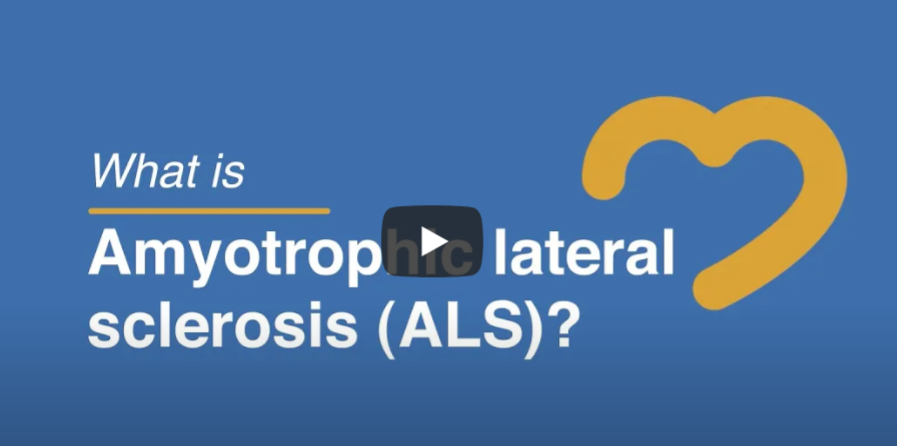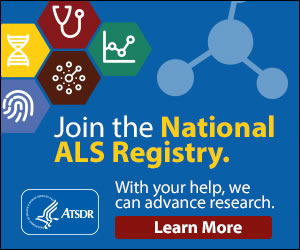
Amyotrophic Lateral Sclerosis (ALS)
Amyotrophic Lateral Sclerosis (ALS)
Table of Contents
- What is amyotrophic lateral sclerosis (ALS)?
- Who gets ALS?
- What causes ALS?
- What are the symptoms of ALS?
- What is the life expectancy in ALS?
- What can be done about ALS?
- What is the status of ALS research?
Last updated April 19, 2024
What is amyotrophic lateral sclerosis (ALS)?

ALS is a disease of the parts of the nervous system that control voluntary muscle movement. In ALS, motor neurons (nerve cells that control muscle cells) are gradually lost. As these motor neurons are lost, the muscles they control become weak and then nonfunctional, thus leading to muscle weakness, disability, and eventually death. ALS is the most common form of motor neuron disease.
The word "amyotrophic" comes from Greek roots that mean "without nourishment to muscles" and refers to the loss of signals nerve cells normally send to muscle cells. "Lateral" means "to the side" and refers to the location of the damage in the spinal cord. "Sclerosis" means "hardened" and refers to the hardened nature of the spinal cord in advanced ALS.
In the United States, ALS also is called Lou Gehrig's disease, named after the New York Yankee baseball player who lived with it until his death in 1941. This disease was first described by Dr. Jean-Martin Charcot in the 19th century.
Who gets ALS?
ALS usually strikes in late middle age (the late 50s is average) or later, although it can occur in young adults as well as in very elderly people. Some forms of ALS have their onset in youth. Men prior to the age of 65 or 70 are slightly more likely to develop ALS than are women. In the US, 1 to 3 new cases of ALS per 100,000 people are diagnosed every year; this is believed to be the same worldwide.
MDA partners with the Centers for Disease Control and Prevention to promote the National ALS Registry, the only national population-based registry in the U.S. that collects information to help scientists learn more about who gets ALS and what may cause it. Learn more by clicking below.
What causes ALS?
The causes of the vast majority of ALS cases are still unknown. Investigators theorize that some individuals may be genetically predisposed to developing the disease but do so only after coming into contact with an environmental trigger. The interaction of genetics and environment may hold clues as to why some individuals develop ALS.
Although the majority of ALS cases are sporadic, meaning there is no family history of the disease, about 10% of cases are familial, meaning the disease runs in the family. A common misconception is that only familial ALS is "genetic." Actually, both familial and sporadic ALS can stem from genetic causes, and some people who have a diagnosis of sporadic ALS may carry ALS-causing genetic mutations that can be passed on to offspring. A genetic counselor can help people with ALS understand inheritance and any associated risks for family members.
For a more detailed discussion of possible causes of sporadic ALS and the genetics of familial ALS, please see Causes/Inheritance.
What are the symptoms of ALS?
ALS results in muscles that are reduced in size (atrophic), weak, and soft, or muscles that are stiff, tight, and spastic. Muscle twitches and cramps are common; they occur because degenerating axons (long fibers extending from nerve-cell bodies) become "irritable."1 Symptoms may be limited to a single body region, or mild symptoms may affect more than one region. When ALS begins in the bulbar motor neurons, localized in the brainstem, the muscles used for swallowing and speaking are affected first. Rarely, symptoms begin in the respiratory muscles. 2
As ALS progresses, symptoms become more widespread, and some muscles become paralyzed while others are weakened or unaffected. In late-stage ALS, most voluntary muscles are paralyzed.
The involuntary muscles, such as those that control the heartbeat, gastrointestinal tract and bowel, bladder, and sexual functions are not directly affected in ALS. Sensations, such as vision, hearing, and touch, are also unaffected.
In many cases, ALS does not affect a person's thinking ability. However, as many as 50% of people with ALS develop some degree of cognitive (thinking) or behavioral abnormalities.3,4
For more information on ALS symptoms, see Signs and Symptoms and Medical Management.
What is the life expectancy in ALS?
Each person's disease course is unique.
From the time of diagnosis, most patients die within three to five years. Around 30% of ALS patients are alive beyond five years after diagnosis, and 10-20% of patients survive 10 years or more. Survival beyond 20 years is possible but rare. Factors associated with more favorable survival rates include a younger age, male gender, and limb rather than bulbar symptom onset. 5,6
For more information on the disease course, see Medical Management.
What can be done about ALS?
Medical interventions and technology have vastly improved the quality of life for people with ALS by assisting with breathing, nutrition, mobility, and communication. Proper management of symptoms, and proactive use of medical interventions and equipment, can make a positive difference in day-to-day living and potentially may lengthen life.
In 1995, the glutamate blocker riluzole (Rilutek) became the first treatment approved by the U.S. Food and Drug Administration (FDA) to treat ALS. In people with ALS, the neuronal signaling molecule glutamate accumulates abnormally in the brain and causes death of motor neurons. Rilutek blocks the release of glutamate, thereby protecting motor neurons from cell death. Alternative formulations of Rilutek have been developed, which allow the drug to be easier to take for individuals who have difficulty swallowing. Tiglutek, an oral liquid formulation of Rilutek was approved in 2018 and, Exservan, an oral formulation of Rilutek that dissolves on the tongue, was approved in the US in 2021. By offering new formulations of Rilutek, the drug will be easier to take for individuals who have difficulty swallowing. For more information, see press releases for Tiglutik approval and Exservan approval.
Dextromethorphan HBr and quinidine sulfate (Nuedexta) was approved in 2010, for treatment of pseudobulbar affect (PBA), a condition experienced by 15-45% ALS patients.
On May 5, 2017, the FDA approved edaravone (Radicava) for the treatment of ALS. Radicava is an intravenous (IV) therapy for adults. For more information, see FDA Approves Radicava to Treat ALS. On May 12, 2022, the FDA granted approval to oral edaravone (RADICAVA ORS) for the treatment of ALS. Radicava is thought to protect neurons from the damage caused by oxidative stress in people with ALS. The oral formulation of RADICAVA provides more flexibility by allowing people to take the drug by mouth or via feeding tube, rather than requiring an IV.
On September 29, 2022, the FDA approved the neuroprotective therapy sodium phenylbutyrate and taurursodiol (Relyvrio) for the treatment of ALS. On April 4, 2024, Amylyx Pharmaceuticals made a voluntary decision to remove Relyvrio from the market after it did not meet its primary or secondary endpoints in a phase 3 study. Read more here.
Most recently, on April 25, 2023, the FDA granted accelerated approval of tofersen (Qalsody) for the treatment of amyotrophic lateral sclerosis associated with mutation in the superoxide dismutase 1 (SOD1) gene (SOD1-ALS). Qalsody is the fourth approved therapy to treat a form of ALS and the first therapy to target a genetic cause of ALS.
What is the status of ALS research?
A number of strategies and approaches are being tested around the world, both in the laboratory and in human clinical trials. MDA's basic science program is constantly pursuing new avenues of research to understand the underlying causes of ALS, with a sharp focus on developing treatments.
One of the most significant breakthroughs in the last decade has been the discovery of a number of genes that, when flawed, cause ALS. In fact, the genes responsible for causing the majority of the familial forms of ALS are now known — with some of these genes also having been found to be involved in sporadic ALS. Identification of these genes is crucial to moving research forward because it allows researchers to better understand the causes of ALS and design therapies to target them. For details about current ALS research, go to Research and Clinical Trials.
MDA takes a big-picture perspective on neuromuscular diseases, including ALS, so we can work across conditions to find effective treatments and cures.
With our collective strength, we encourage early diagnosis and action, support families in hometowns across the country, and uncover research breakthroughs to help everyone with ALS live longer, stronger lives.
- Download our ALS Impact Sheet to see how MDA supports families living with ALS and uses your donations to help find treatments and cures.
- Download our ALS Fact Sheet
- Watch MDA Facebook Live: ALS Care and Research Updates to learn about the latest in care and research updates related to ALS.
References
- Chiò, A., Mora, G. & Lauria, G. Pain in amyotrophic lateral sclerosis. The Lancet Neurology (2017). doi:10.1016/S1474-4422(16)30358-1
- Hardiman, O., Van Den Berg, L. H. & Kiernan, M. C. Clinical diagnosis and management of amyotrophic lateral sclerosis. Nature Reviews Neurology (2011). doi:10.1038/nrneurol.2011.153
- Strong, M. J., Lomen-Hoerth, C., Caselli, R. J., Bigio, E. H. & Yang, W. Cognitive impairment, frontotemporal dementia, and the motor neuron diseases. in Annals of Neurology (2003). doi:10.1002/ana.10574
- Lomen-Hoerth, C. et al. Are amyotrophic lateral sclerosis patients cognitively normal? Neurology (2003). doi:10.1212/01.WNL.0000055861.95202.8D
- Kim, W. K. et al. Study of 962 patients indicates progressive muscular atrophy is a form of ALS. Neurology (2009). doi:10.1212/WNL.0b013e3181c1dea3
- Visser, J. et al. Disease course and prognostic factors of progressive muscular atrophy. Arch. Neurol. (2007). doi:10.1001/archneur.64.4.522
- Miller, R. G., Mitchell, J. D., Lyon, M. & Moore, D. H. Riluzole for amyotrophic lateral sclerosis (ALS)/motor neuron disease (MND). Amyotrophic Lateral Sclerosis and Other Motor Neuron Disorders (2003). doi:10.1080/14660820310002601


